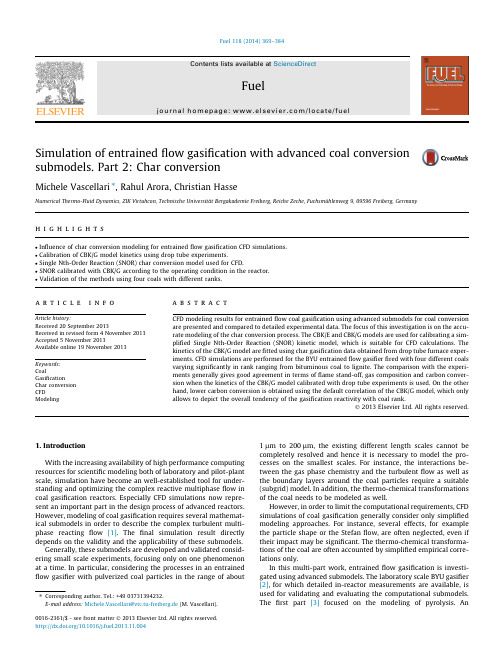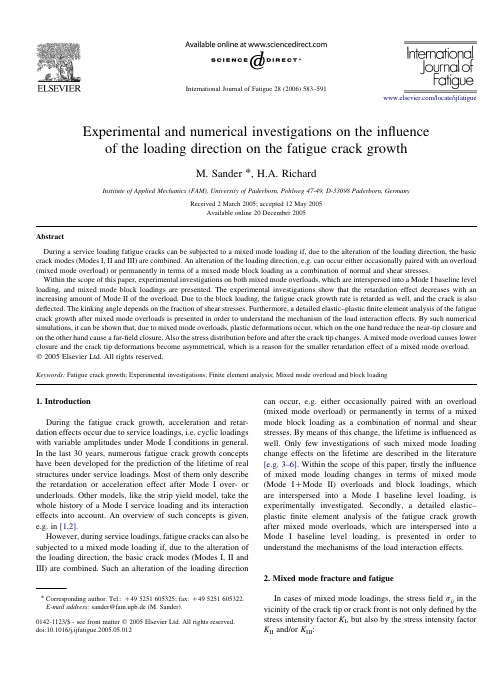Experimental and Numerical Study on Vibration of the Full-Revolving Propulsion Ship Stern
- 格式:pdf
- 大小:1.14 MB
- 文档页数:16

ReviewStudy on the pharmacological activities and chemicalstructures of Viburnum dilatatumZhiheng Gao, Yufei Xi, Man Wang, Xiaoxiao Huang*, Shaojiang Song*Key Laboratory of Computational Chemistry-Based Natural Antitumor Drug Research &Development, Liaoning Province, School of Traditional Chinese Materia Medica, ShenyangPharmaceutical University, Shenyang 110016, ChinaAbstractViburnum dilatatum (jiami in Chinese), belonging to the Caprifollaceae family, is widely distributed in Japan and China. Phytochemical investigations of Viburnum dilatatum (V. dilatatum) have resulted in the isolation of triterpenoids, phenolic glycosides essential oil, norisoprenoids, etc. Research results have shown that the chemical constituents of V. dilatatum possess various pharmacological activities, including antihyperglycemic, antioxidant activity and antiulcer effects. This study reviewed the chemical constituents and pharmacological activities of V. dilatatum to provide practical and useful information for further research and development of this plant.Keywords: Viburnum dilatatum; pharmacological activity; chemical structures1 IntroductionViburnum dilatatum (called jiami in Chinese, gamazumi in Japanese and snowball tree in English), beloinging to family Caprifoliaceae, is a deciduous low tree distributed widely in the hills of northern China and Japan [1]. There are many types of chemical constituents in Viburnum dilatatum (V. dilatatum), including triterpenoids, * Author to whom correspondence should be addressed. Address:School of Traditional Chinese Materia Medica, Shenyang Pharmaceutical University, 103 Wenhua Rd., Shenyang 110016, China; Tel.: +86-24-43520793 (Xiaoxiao Huang); +86-24-43520707 (ShaojiangSong);E-mail:*******************(XiaoxiaoHuang); ****************(ShaojiangSong).Received: 2021-04-16 Accepted: 2022-08-28phenolic glycosides and norisoprenoids [2-4]. The leaves have been utilized as a traditional Chinese medicine, and phenolic compounds have been reported as the main active chemical component of the leaves. Many researchers have analyzed the functions of these medicinal components and found that these components have good antioxidant antihyperglycemic and antiulcer effects. For example, the gamazumi crude extract obtained from the squeezed juice of the fruit prevented oxidative injury in rats [5]. This review described the chemical structures and pharmacological activities of V. dilatatum, so as to help readers understand comprehensively the research progress of V. dilatatum and provide help for the development of V. dilatatum.2 Chemical constituents and structuresPrevious reports have indicated that the main chemical constituents of V. dilatatum are phenolic glycosides and triterpenoids.2.1 Phenolic glycosidesThirteen phenolic glycosides were isolated and identified from V. dilatatum by extensive spectroscopic methods, namely p -hydroxyphenyl-6-O -trans-caffeoyl-β-D -glucoside (1) [6], p -hydroxyphenyl-6-O -trans-caffeoyl-β-D -alloside (2) [6], 4-allyl-2-methoxyphenyl-6-O -β-D -apiosyl(1→6)-β-D -glucoside (3) [6], 1-(4’-hydroxy-3’-methoxypheny1)-2-[2’’-hydroxy-4’’-(3’’’-hydroxypropyl)]-1,3-propanediol-l-O -β-D -glucopyranoside (erythro isomer) (4-7) [7], neochlorogenic acid methyl ester (8-9) [7], cryptochlorogenic acid methyl ester (10-11) [7], cyanidin-3-sambubioside (Cy-3-sam) (12) [8], cyanidin-3-glucoside (Cy-3-glc) (13) [8], 5-O -caffeoyl-4-methoxyl quinic acid (4-MeO-5-CQA) (14) [8], chlorogenic acid (5-CQA) (15) [8], quercetin (16) [8], 2-(glucopyranosyloxy)-benzyl-3-(glucopyranosyloxy)-benzoate (17) [9] and jiamizioside E (18) [10]. These structures are shown in Fig. 1.Fig. 1 Phenolic glycosides isolated from V . dilatatumContinued fig. 12.2 TriterpenoidsThere were about seventeen triterpenoids isolated and characterized from V. dilatatum , such as viburnols A (19) [11], viburnols B (20) [11], viburnols C (21) [11], viburnols D (22) [11], viburnols E (23) [11], viburnols F (24) [12], viburnols G (25) [12], viburnols H (26) [12], viburnols I (27) [12], viburnols J (28) [12],viburnols K (29) [12], viburnudienone B 2methyl ester (30) [13], viburnenone H 2 (31) [13],v i b u r n e n o n e B 2 m e t h y l e s t e r (32) [13], viburnudienone B 1 methyl ester (33) [13], viburnenone H 1 (34) [13], and viburnenone B 2 methyl ester (35) [13]. The structures are shown in Fig. 2.Continued fig. 23 Pharmacological activities3.1 Antioxidant activityOxidative stress caused by free radicals and their derivatives leads to disturbances in redox homeostasis. Reactive oxygen species (ROS) are not only endogenously produced during intracellular metabolic processes but also generated by exogenous stimuli such as UV radiation, pollutants, smoke and drugs. The cell triggers its defense systems or undergoes apoptosis when intracellular oxidative status increases. It influences numerous cellular processes including core signaling pathways, which are associated with development of systematic and chronic disorders, such as aging and cancer. Therefore, it is critical to remove cellular oxidants and restore redox balance.solution of V. dilatatum (GSS) had strong antioxidant activity in vivo and prevent stress-induced oxidative damage by the XYZ-dish method and the澳electron spin resonance (ESR) method [14]. The experimental result showed that the concentrations of lipid peroxide in plasma, liver and stomach in the GSS group were reduced. Furthermore, the activities of plasma lactic dehydrogenase, amylase and creatine phosphokinase are ordinarily increased by stress. However, these activities in the GSS group decreased to that in the control group. It was concluded that gastric ulcer formation, increase of lipid peroxidation in plasma and tissues and elevation of plasma enzymatic activities were confirmed in rats with water immersion restraint stress. It was also found that intake of GSS could protect the stomach and other tissues from oxidative damage.Kim et al. identified and isolated two major anthocyanins by NMR and LC-ESI-MS/MS, namely, cyanidin 3-sambubioside (I) and kuromanin (II) [15]. By the electron spin resonance method, the superoxide anion radical scavenging activities of I and II were evaluated with the IC 50 values of 17.3 and 69.6 µM, and their activities on hydroxyl radicals were evaluated with the IC 50 values of 4.3 and 53.2 mM. As the positive control, the IC 50 values of ascorbic acid were 74.2 µM on superoxide anion radicals and 3.0 mM on hydroxyl radicals, respectively. The above results suggested that these anthocyanins with radical scavenging properties might be the key compounds contributing to the antioxidant activity and physiological effects of V . dilatatum fruits.Woo et al. determined the free radical scavenging capacity of VD (the leaves of V. dilatatum ) [16]. Anti-oxidant activity of the extracts was assessed by the ability to scavenge 2,2-diphenyl-1-picrylhydrazyl (DPPH) or 3-ethylbenzothiazoline-6-sulfonic acid (ABTS) radicals. Butylated hydroxytoluene (BHT), a synthetic antioxidant, or α-tocopherol, was used as the positive control in these assays. The experimental result showed that VD inducedincrease in radical scavenging activity. In addition, lipid peroxidation inhibitory activity was determined via measurement of MDA (Malondialdehyde) levels using mouse liver tissue homogenate treated with various concentrations of the extracts. The concentration-dependent decrease in MDA levels observed was consistent with radical scavenging activities of the extracts. To examine whether VD extracts could protect mam-malian cells from oxidative stress, cultures of a human mammary gland-derived epithelial cell line MCF-7 were treated with each extract prior to challenging them with tBHP. The intracellular ROS (Reactive oxygen species) production was determined with the relative intensity of dichlorofluorescein fluorescence. While intracellular ROS formation was significantly promoted by tBHP treatment, the augmented ROS level was significantly reduced after the treatment with VD extracts.3.2 Antihyperglycemic effectIwai et al. used an oral glucose tolerance test on the diabetic rats [17]. They found that the elevation of plasma glucose level after oral administration of 2 g/kg glucose was suppressed by the repeated administration of the freeze-dried powder of V. dilatatum fruit juice (CEV). The α-glucosidase inhibitory activities of isolated compounds from CEV were also measured. Cyanidin 3-sambubioside and 5-caffeoyl quinic acid A showed inhibitory activity. These results suggested that V. dilatatum fruit had the antihyperglycemic effects.4 ConclusionV. dilatatum is distributed widely in the hills of northern China and Japan. Currently, the studies on V. dilatatum have been conducted at home and abroad, but few studies focus on its chemical components and pharmacological activities. Previousphytochemical investigations showed that the constituents of V. dilatatum included triterpenoids, phenolic glycosides, norisoprenoids and other compounds. This study describes thirteen phenolic glycosides and seventeen triterpenoids and their different degrees of antihyperglycemic, antioxidant activity and antiulcer effects, aiming to provide a reference for further studies on V. dilatatum and pharmaceutical development.References[1] Jeffrey B, Harborne A. Colour atlas of medicinal plantsof Japan. Phytochemistry, 1981, 20: 1467.[2] Miyazawa M, Hashidume S, Takahashi T, et al. Aromaevaluation of gamazumi (Viburnum dilatatum) by aroma extract dilution analysis and odour activity value.Phytochem Anal, 2012, 23: 208-213.[3] Kurihara T, Kikuchi M. Studies on the constituentsof flowers. IV. On the components of the flower of Viburnum dilatatum Thunb. J Health Sci, 1975, 95: 1098-1102.[4] Machida K, Kikuchi M. Norisoprenoids from Viburnumdilatatum. Phytochemistry, 1996, 41: 1333-1336. [5] Iwai K, Onodera A, Matsue H. Mechanism of preventiveaction of Viburnum dilatatum Thunb (gamazumi) crude extract on oxidative damage in rats subjected to stress. J Sci Food Agric, 2010, 83: 1593-1599.[6] Machida K, Nakano Y, Kikuchi M. Phenolic glycosidesfrom Viburnum dilatatum. Phytochemistry, 1991, 30: 2013-2014.[7] Machida K, Kikuchi M. Phenolic compounds fromViburnum dilatatum. Phytochemistry, 1992, 31: 3654-3656.[8] Kim MY, Iwai K, Matsue H. Phenolic compositions ofViburnum dilatatum Thunb. fruits and their antiradical properties. J Food Compos Anal, 2005, 18: 789-802. [9] Lu D, Yao S. Phenolic glycoside from the roots ofViburnum dilatatum. Nat Prod Commun, 2009, 4: 945-946.[10] Wu B, Zeng X, Zhang Y. New metabolite fromViburnum dilatatum. Nat Prod Commun, 2010, 5: 1097-1098.[11] Machida K, Kikuchi M. Viburnols: Novel triterpenoidswith a rearranged dammarane skeleton from Viburnum dilatatum. Tetrahedron Lett, 1996, 37: 4157-4160. [12] Machida K, Kikuchi M. Viburnols: Six noveltriterpenoids from Viburnum dilatatum. Tetrahedron Lett, 1997, 38: 571-574.[13] Machida K, Kikuchi M. Studies on the Constituents ofViburnum Species. XIX. Six New Triterpenoids from Viburnum dilatatum Thunb. Chem Pharm Bull, 1999, 47: 692-694.[14] Iwai K, Onodera A, Matsue H, et al. Antioxidant activityand inhibitory effect of Gamazumi (Viburnum dilatatum THUNB.) on oxidative damage induced by water immersion restraint stress in rats. Int J. Food Sci Nutr, 2001, 52: 443-451.[15] Kim MY, Iwai K, Onodera A, et al. Identification andAntiradical Properties of Anthocyanins in Fruits of Viburnum dilatatum Thunb. J Agric Food Chem, 2003, 51: 6173-6177.[16] Woo YJ, Lee HJ, Jeong YS, et al. Antioxidant Potentialof Selected Korean Edible Plant Extracts. Bio Med Res Int, 2017, 2017: 1-9.[17] Iwai K, Kim MY, Akio O, et al. Alpha-glucosidaseinhibitory and antihyperglycemic effects of polyphenols in the fruit of Viburnum dilatatum Thunb. J Agric Food Chem, 2006, 54: 4588-4592.。

高一英语学术研究方法单选题40题1. What is a research hypothesis?A. A statement that is always true.B. A prediction about the relationship between variables.C. A conclusion based on research findings.D. A question that needs to be answered.答案:B。
选项A,研究假设不是总是正确的陈述。
选项C,研究假设是在研究之前做出的预测,不是基于研究发现的结论。
选项D,研究假设不是一个需要回答的问题,而是对变量之间关系的预测。
2. What is a literature review?A. A summary of all the books on a topic.B. A critical analysis of existing research on a topic.C. A collection of research papers.D. A list of research questions.答案:B。
选项A,文献综述不仅仅是对一个主题的所有书籍的总结。
选项C,文献综述不是简单的研究论文集合。
选项D,文献综述不是研究问题列表。
3. What is a research method?A. A way to collect data.B. A theory about a topic.C. A conclusion from research.D. A list of research questions.答案:A。
选项B,研究方法不是关于一个主题的理论。
选项C,研究方法不是研究得出的结论。
选项D,研究方法不是研究问题列表。
4. What is a sample in research?A. A part of the population being studied.B. The entire population.C. A list of research questions.D. A research method.答案:A。




服役环境下拉索全寿命腐蚀曲线分析鲍烜平;何政【摘要】腐蚀问题是斜拉桥拉索运营状态下性能最重要的影响因素之一.腐蚀会导致拉索截面削减,构件承载力下降,同时对其抗疲劳性能、延性等性能也会产生重大影响.拉索受力截面积的变化作为衡量拉索腐蚀程度的参数,在研究拉索在腐蚀环境下的各类性能研究都有重要意义.文中综合考虑应力、腐蚀环境以及随机性因素等对拉索腐蚀作用的影响,结合全寿命设计理论,提出腐蚀拉索截面变化率这一参数并通过分段刻画拉索在腐蚀作用下对拉索构件截面变化的影响,建立了一种将统计方法、加速腐蚀试验等相结合的方法以获取服役期内的该参数全寿命时间关联曲线,为拉索寿命的评估和拉索在服役环境下的性能研究提供基础和参考.【期刊名称】《低温建筑技术》【年(卷),期】2014(036)008【总页数】3页(P49-51)【关键词】斜拉桥;拉索;腐蚀;截面变化率;使用寿命【作者】鲍烜平;何政【作者单位】大连理工大学土木工程学院,辽宁大连116024;大连理工大学土木工程学院,辽宁大连116024【正文语种】中文【中图分类】TU392.2拉索内镀锌钢丝的腐蚀相关问题已得到国内外学者广泛关注,加速试验[1]是研究拉索腐蚀机理的主要方法;Deeble等[2]通过实验分析悬索桥拉索腐蚀监测结果,得出温度和相对湿度对拉索腐蚀的影响;Yang等[3]通过盐雾试验分析了拉应力对拉索腐蚀的影响;徐俊等[4]结合实验数据结果分析和数值模拟研究了钢丝力学性能随腐蚀发展的变化规律;Li等[5]提出了以质量损失为标准的拉索腐蚀评定方法;Li等[6]及Nakamura等[7]通过加速腐蚀试验,得出腐蚀对拉索的疲劳寿命存在较大影响;Suzumura等[8]针对拉索镀锌钢丝通过试验方法探究了镀锌钢丝的腐蚀速率影响因素;Barton 等[9]和 Betti等[10]通过加速腐蚀试验发现腐蚀作用下拉索钢丝断裂的伸长率较无腐蚀状态发生变化;对于应力问题,梁雄[11]通过加速试验对模拟酸雨环境下的镀锌钢丝镀锌层在不同应力水平的腐蚀速度进行分析,研究表明应力对镀锌层腐蚀速率有影响。
丁醇近年来,采⽤缸内直喷⾼活性燃料+⽓道喷射低活性燃料的双燃料(或RCCI)燃烧模式已成为国内外的研究热点。
该模式能够通过调节缸内⼯质的活性分布和梯度有效地控制燃烧相位、放热规律并降低压⼒升⾼率,可在全⼯况范围内实现稳定燃烧[1-2]。
相关研究表明[3-7]双燃料燃烧模式在提⾼热效率和降低污染物排放⽅⾯极具潜⼒。
Kokjoh[8]等研究发现,与传统柴油燃烧相⽐,采⽤汽油-柴油双燃料燃烧模式能使指⽰热效率提⾼约16.4%。
Splitter[9]等也指出,汽油-柴油双燃料燃烧模式可使指⽰热效率达到约60%。
此外,Benajes[10]、尧命发[11]等研究发现,采⽤双燃料燃烧模式可在不使⽤后处理技术条件下使NOx和Soot排放接近于0。
从表5可以看出,对奖学⾦评定持不同看法的⼤学⽣在求知兴趣、利他取向维度上得分存在差异,在声誉获取维度上存在极其显著的差异。
表明认为奖学⾦评定合理的⼤学⽣⽐认为不合理的⼤学⽣更享受学习的乐趣,更注重能⼒的提升,更在乎他⼈的评价。
⽬前,醇类燃料(如甲醇、⼄醇、丁醇等)作为低活性燃料已被⼴泛应⽤于双燃料燃烧模式。
与甲醇、⼄醇相⽐,丁醇具有较⾼热值、较⾼能量密度、较⾼闪点、密度与柴油接近、对燃油管路⽆腐蚀性等优异的物理化学性质,已被认为是⼀种更具潜⼒的应⽤于双燃料燃烧模式的低活性燃料[12-13]。
针对采⽤丁醇作为低活性燃料的双燃料燃烧模式,国内外学者已开展了⼤量的研究⼯作。
Chen[14]等对正丁醇-柴油双燃料燃烧的研究结果表明,在低EGR率(15%)时,正丁醇⽐例的增加将增⼤缸压峰值和放热率峰值,减⼩燃烧持续期;⽽在⾼EGR率(45%)时,正丁醇⽐例的增加降低了缸压峰值和放热率峰值,并使着⽕始点推迟、燃烧持续期增加。
Soloiu[15]等指出正丁醇-⽣物柴油双燃料燃烧可通过控制燃烧相位改变NOx-Soot的折中关系,同时使NOx和Soot分别降低74%和98%。
Ruiz[16]等还研究了正丁醇-柴油双燃料燃烧模式对颗粒物物理化学性质的影响。
科研与实践英语作文The Excitement of Scientific Research。
There's just something magical about dipping into the unknown. You know, when you're in the lab, staring at that microscope, and suddenly you see something new? It's like discovering a whole new world. And then the race begins to understand it, to figure out what it means.The Challenges of Hands-on Work。
Yeah, sure, the theory's great, but there's nothing like getting your hands dirty. You know, trying out that experiment for the hundredth time, only this time something's not working right. Frustrating, right? Butthat's when the real learning starts. You start troubleshooting, thinking outside the box.The Joy of Sharing Discoveries。
I love when I finally figure something out and can tell my team. The excitement on their faces, the sense of accomplishment we share, it's just indescribable. And then there's that moment when you realize your work might actually impact the world, even if it's in a small way.The Unexpected Joys of Research。
带式输送机转载点粉尘浓度分布数值模拟秦翥【摘要】针对目前带式输送机转载点粉尘治理的研究主要限于除尘或降尘等具体措施且粉尘治理效果不理想的问题,从转载点粉尘形成诱因出发,分析了煤料在转载点运输过程中形成的诱导气流、剪切气流和牵引气流对粉尘析出的影响;以直线型转载点煤料受力为例,得出影响粉尘浓度分布的转载点结构参数;利用Fluent软件对不同转载点倾角、截面积及截面形状下粉尘浓度分布进行了数值模拟,结果表明:转载点倾角越大,粉尘分布范围越大,转载点出口处粉尘浓度越高;转载点截面积越大,转载点出口处粉尘浓度越低;转载点截面积相同但截面形状不同时,圆形截面转载点粉尘浓度最低.【期刊名称】《工矿自动化》【年(卷),期】2018(044)007【总页数】5页(P70-74)【关键词】带式输送机;转载点;粉尘浓度;粉尘治理【作者】秦翥【作者单位】中煤科工集团上海有限公司,上海200030【正文语种】中文【中图分类】TD7140 引言在煤矿运输过程中,带式输送机转载点的粉尘污染问题较为突出[1]。
煤料在转运过程中形成的小粒径粉尘长期悬浮在空气中,危害职工健康;大粒径粉尘虽然可在短时间内自然沉降,但在后续煤料的冲击下会被再次扬起[2-3]。
在密闭环境中,粉尘浓度过高时极易引发爆炸,严重威胁生产安全[4-5]。
目前,对带式输送机转载点粉尘治理的研究主要限于除尘或降尘等具体措施[6-10],缺乏对转载点粉尘形成诱因的分析,较难达到理想的粉尘治理效果。
本文从粉尘产生与转载点结构的关系出发,利用Fluent软件对不同倾角、截面积及截面形状下转载点粉尘浓度分布进行数值模拟,旨在为通过优化转载点结构来抑制粉尘污染提供理论依据。
1 粉尘析出机理(1) 诱导气流引发的粉尘。
煤料进入转载点入口处后,由水平匀速直线运动转为离心抛物加速运动,使转载点密闭空间内的气体共同运动,形成诱导气流[11]。
当煤料下滑接近受料输送带时,煤料的势能逐渐转化为动能,使转载点出口处诱导气流随之增大,将小粒径固体颗粒从煤料中剥离,造成落料时粉尘外溢。